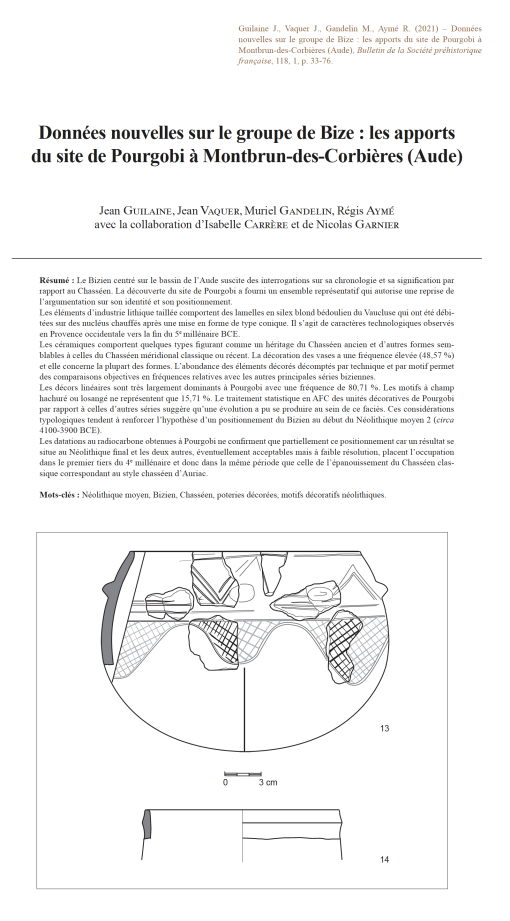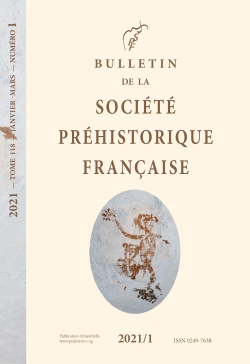Prix : 15,00 €TTC
02-2021, tome 118, 1, p. 33-76 - J. GUILAINE, J. VAQUER, M. GANDELIN, R. AYME, avec la collaboration d'I. CARRERE et de N. GARNIER
Données nouvelles sur le groupe de Bize : les apports du site de Pourgobi à Montbrun-des-Corbières (Aude), p.33-76
Jean Guilaine, Jean Vaquer, Muriel Gandelin, Régis Aymé, avec la collaboration de, Isabelle Carrère & Nicolas Garnier
Résumé : Le Bizien centré sur le bassin de l'Aude suscite des interrogations sur sa chronologie et sa signification par rapport au Chasséen. La découverte du site de Pourgobi a fourni un ensemble représentatif qui autorise une reprise de l'argumentation sur son identité et son positionnement. Les éléments d'industrie lithique taillée comportent des lamelles en silex blond bédoulien du Vaucluse qui ont été débitées sur des nucléus chauffés après une mise en forme de type conique. Il s'agit de caractères technologiques observés en Provence occidentale vers la fin du 5e millénaire BCE. Les céramiques comportent quelques types figurant comme un héritage du Chasséen ancien et d'autres formes semblables à celles du Chasséen méridional classique ou récent. La décoration des vases a une fréquence élevée (48,57 %) et elle concerne la plupart des formes. L'abondance des éléments décorés décomptés par technique et par motif permet des comparaisons objectives en fréquences relatives avec les autres principales séries biziennes. Les décors linéaires sont très largement dominants à Pourgobi avec une fréquence de 80,71 %. Les motifs à champ hachuré ou losangé ne représentent que 15,71 %. Le traitement statistique en AFC des unités décoratives de Pourgobi par rapport à celles d'autres séries suggère qu'une évolution a pu se produire au sein de ce faciès. Ces considérations typologiques tendent à renforcer l'hypothèse d'un positionnement du Bizien au début du Néolithique moyen 2 (circa 4100-3900 BCE). Les datations au radiocarbone obtenues à Pourgobi ne confirment que partiellement ce positionnement car un résultat se situe au Néolithique final et les deux autres, éventuellement acceptables mais à faible résolution, placent l'occupation dans le premier tiers du 4e millénaire et donc dans la même période que celle de l'épanouissement du Chasséen classique correspondant au style chasséen d'Auriac.
Mots-clés : Néolithique moyen, Bizien, Chasséen, poteries décorées, motifs décoratifs néolithiques.
Abstract: Since its first identification and definition, the Bize group centred on the Aude basin has raised many questions about its chronological position, its significance in relation to the Chasséen and its cultural affinities. Once considered to be a transitional group between the Early and Middle Neolithic, it is now seen as a transitional group between the early Chasséen and the classical or late Southern Chasséen. Its position around 4000 BCE remains hypothetical, despite the growing number of excavations on new sites and the obtainment of several radiocarbon dates that widely overlap with late Chasseen dates. In this context, the Pourgobi site at Montbrun-des-Corbières (Aude), located to the north of the Corbières in a bend of the Aude river and revealed by vineyard deep ploughing that destroyed features, presents the advantages of providing a well-preserved set of finds and justifies reopening the debate on the chronological and cultural position of the Bize group. Survey of the ploughed field produced 16 find-spots of artefacts or burnt stones, corresponding to an equivalent number of destroyed features. Most could not be dated due to the lack of determinable finds. Others can be attributed to the Late Neolithic (2) and the Bronze Age or the Early Iron Age (2). Larger numbers of finds typical of the Bize group were found at spots 15 and 16. Pourgobi is thus a new site with an assemblage representative of the Bize group. Unlike other assemblages from the Aude basin, in which Bize style pottery is mixed with pots showing classical aspects of the Chasséen, this new assemblage can be considered homogeneous, resulting from a short-lived occupation and thus enabling a clearer definition of this original style of the Neolithic in southern France. The lithic finds are few in number but informative. They include prismatic bladelets in Bedoulian honey-coloured flint, knapped from heated conical-shaped cores. These are technological characteristics observed at the beginning of Middle Neolithic 2 in western Provence, where this type of core was manufactured and exported towards the end of the 5th millennium BCE. The lithic industry also includes a few polished stone tools made from local pebbles and grinding equipment consisting of querns, grindstones and hammers. Only one bone tool was found. These finds seem to reflect normal subsistence activities on a Neolithic settlement, ruling out the possibility that the pottery associated was used for special ritual or funerary activities. Pottery is the most significant find category. The assemblage contains 21 vessels with complete profiles, as well as a number of decorated sherds. A high percentage of the pottery is decorated (48.5 %) and this includes most shapes. Due to the quantity of decorated material, counts of techniques and motifs can be used to make objective comparisons in terms of frequency with the other main Bize assemblages. Linear decorations largely predominate at Pourgobi with a frequency of 80.7 %. Cross-hatched or grid motifs, whose role was to fix coloured paste, represent only 15.7 %. Correspondence analysis was used to examine statistically the relationship between decoration at Pourgobi and six other assemblages from the Aude basin. The results suggest that the Bize group sees a development from an early phase with coloured decoration to a later phase with mostly linear decoration. Generally speaking, the Bize style pottery presents a combination of elements that can be grouped into three components. The first includes vessels with a non-segmented profile (plates with a thickened rim, hemispherical or globular bowls, curved pots found at Pourgobi), together with segmented shapes such as the deep carinated bowl, wide-rimmed plate and pyxis which are clearly a legacy of the early Chasséen, as are the numerous hatched or lozenge decoration motifs. The second component, more specifically in the Bize style, includes segmented shapes such as shallow carinated bowls, whose cap-shaped body was probably formed with a basket, and the short, flared wall added using a single coil. The joint between the two parts is visible as a hollow on the inner side. Another typical shape is the deeper carinated bowl with concave wall. The main originality of the Bize style lies in the decoration of vessels, generally complex and extensive, with the use of particular techniques such as dotted impressions, combinations of various techniques (broad or narrow grooves, engraving, coloured incrustations) and especially curvilinear arch, garland or meander motifs. The third component presents traits that are found in assemblages of the classic or late Languedoc Chasséen (Auriac and Cavanac-Toronde style). Particularly noteworthy at Pourgobi are the many cap-shaped bowls, the most common category throughout the Middle Neolithic 2, especially the variant with a groove drawn along the inner side of the rim and sometimes "moustache" decoration linking the suspension lugs. This type is present on several Bize sites but in a more complex form, notably with rectilinear recto-verso decoration that could be the archetype of the simplified motifs of the classic and final Chasséen. Further elements heralding the segmented shapes of the classic and late Chasséen include the shouldered forms or the distinctly necked vessels that can have the customary multiple-perforated lugs. These vessels present grooved or incised linear decoration that can occur in simplified form in the classic and late Chasséen. In terms of decoration motifs, the Pourgobi assemblage appears to hold an intermediate position between assemblages with frequent and extensive coloured decoration, as on the eponymous site, and other assemblages with simplified or limited decoration such as La Salle at Carcassonne or Poste-Vieille at Pezens. These variations suggest that the Bize style lasted a certain length of time and can be divided into an early period of engraved decoration (hatching and lozenges), in the early Chasséen tradition, and a later period with incised or grooved linear decoration, forerunning the Chasséen Auriac style. These typological considerations rather support the hypothesis that the Bize group dates to the beginning of Middle Neolithic 2, either at the end of the 5th millennium or the beginning of the 4th millennium BCE. The radiocarbon dates from Pourgobi only partially confirm this chronological position. One date corresponds to the final Neolithic and the other two lie in the first third of the 4th millennium BCE, the period when the classic Chasséen flourished, corresponding to the Auriac style.
Keywords: Middle Neolithic, Bize, Chasséen, decorated pottery, Neolithic decoration motifs.




